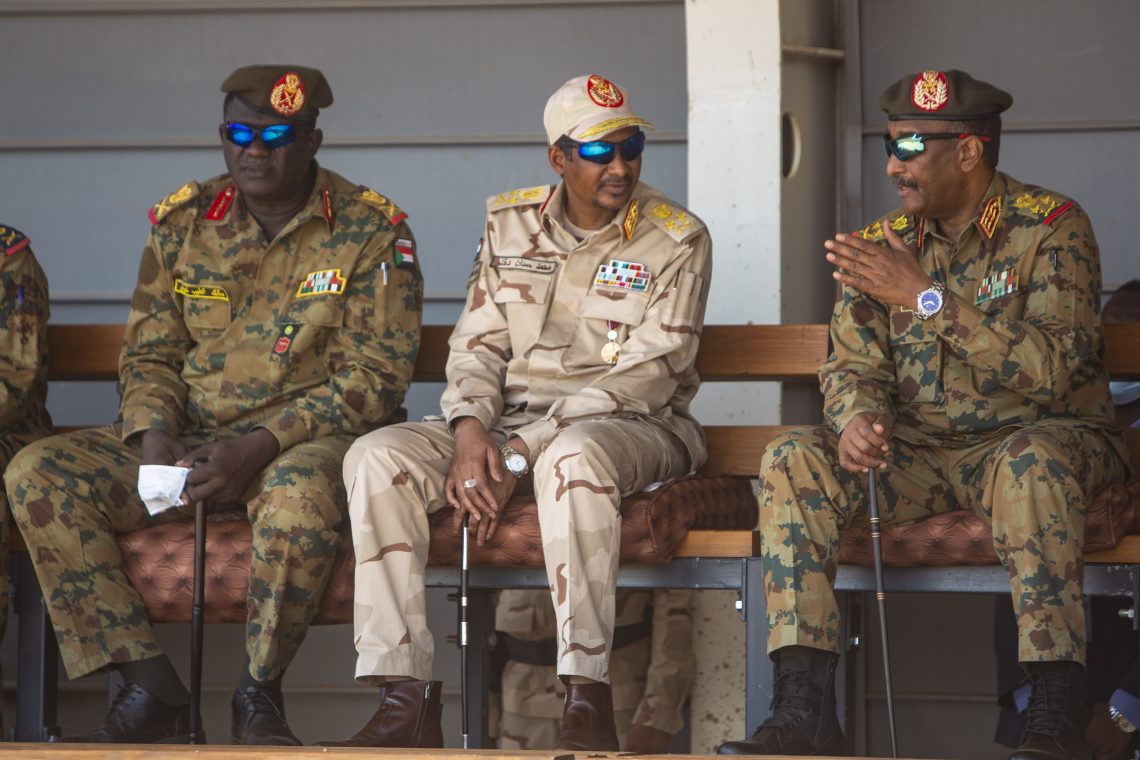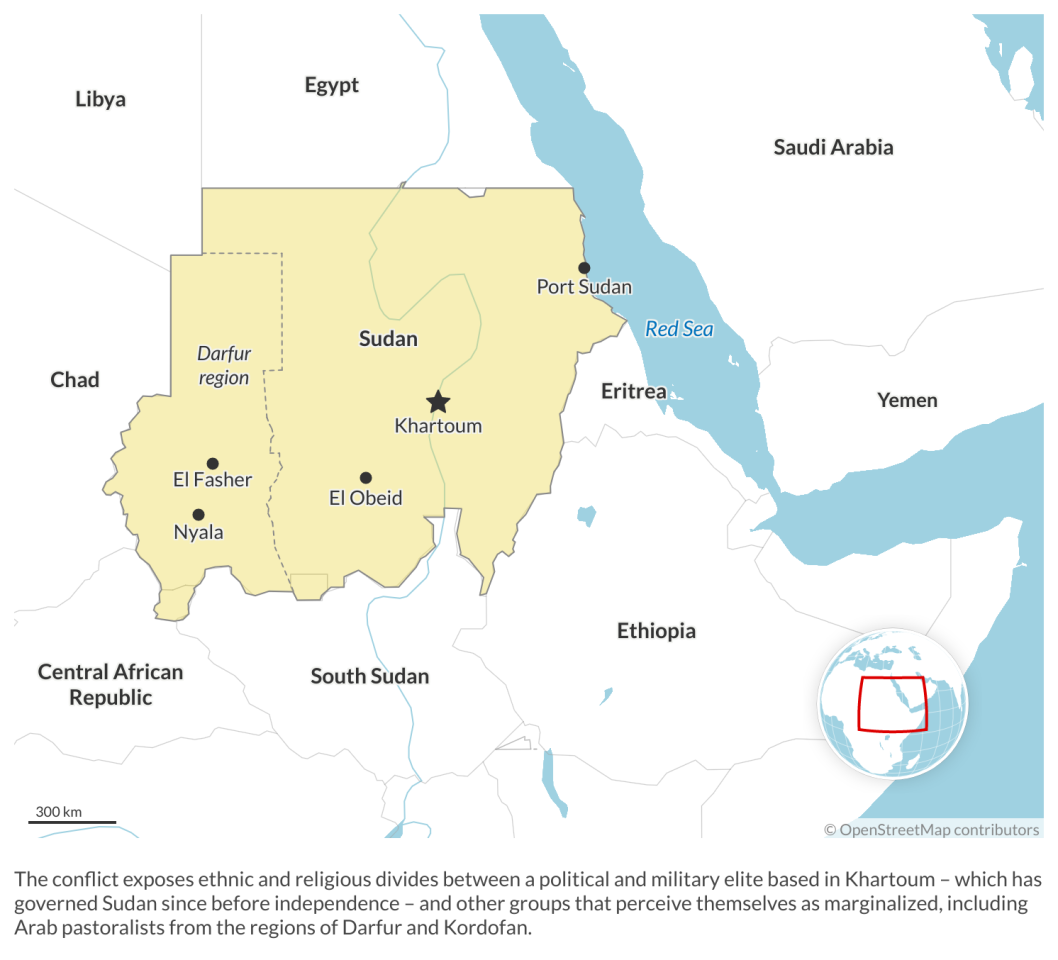Stability in Sudan remains out of reach
With neither side having a clear path to victory, the ongoing clashes in Sudan are likely to drag on, precluding any transition soon to civilian or democratic rule.

In a nutshell
- The conflict in Sudan exposes deep ethnic and religious divides
- Recent events have highlighted the limits of the Arab Spring
- Any movement toward civilian, democratic rule is unlikely
Throughout nearly six decades as an independent and sovereign nation, Sudan’s history has been marked by popular uprisings and coups, followed by the establishment of authoritarian, personalized and militarized regimes.
The recent conflict between two strongmen and their respective armed forces – which may escalate into a full-fledged civil war with effects beyond Sudan’s borders – underscores the fragility of a country where dictatorship has often been the price to pay for stability.
Sudanese Spring
President Omar al-Bashir’s regime survived the initial wave of the Arab Spring but was ultimately toppled in 2019 when a new wave of unrest and dissatisfaction rocked North Africa’s resilient authoritarian governments.
The “Sudanese Spring” emerged from two key factors. Firstly, the mobilization of civil society actors during a surge of protests that swept through the country’s urban areas following the removal of wheat and fuel subsidies. Secondly, and decisively, the Sudanese army – a significant supporter of the Bashir regime for decades – decided to oust and arrest the president. Following the coup, which was legitimized by widespread popular protests, Lieutenant General Abdel Fattah al-Burhan assumed power by establishing the Transitional Military Council (TMC).
Unified only by their goal to end Mr. Bashir’s regime, the relationship between the civilian opposition and the military was strained from the outset of the transition process. At the same time, tensions emerged within the TMC as General Mohamed Hamdan Dagalo – the commander of the paramilitary Rapid Support Forces (RSF), often known as Hemedti – challenged the dominant position of General al-Burhan. In 2021, the transitional process was disrupted by a military coup that briefly united the two strongmen. According to Mr. al-Burhan, the coup was necessary to “rectify the revolution’s course.” Facing mounting international pressure, both leaders eventually agreed to return to civilian rule, but clashes between the two military factions finally erupted.
As history in Africa (and elsewhere) indicates, integrating rebel or paramilitary groups into national armies is often a significant obstacle to implementing peace and transitional processes. In the case of Sudan, security sector reform was a crucial prerequisite for stabilization. Tensions between the two strongmen and the forces they commanded were fueled by disagreements over how the RSF should be integrated into the regular army. One of the conditions set by General al-Burhan, backed by Egypt, was the rapid integration of the RSF under his command. On April 15, the RSF launched an assault on the Merowe Air Base in northern Sudan, capturing Egyptian soldiers.
From Darfur to Khartoum
It is crucial to consider Sudan’s recent history to understand the rivalry between the Sudanese Armed Forces and the RSF. The latter, established in 2013 out of the Janjaweed militia, served two primary purposes under President Bashir: acting as a counterweight to the power of the regular military and neutralizing the Sudan People’s Liberation Army-North. The RSF and its predecessor, the Janjaweed, were responsible for much of the violence and atrocities committed in the Darfur region from 2003 to 2006, which saw more than 300,000 victims.
Benefiting from the hybrid status of a paramilitary force, the RSF successfully avoided being controlled by the central power in Khartoum. Its leader, Hemedti, was formerly a leader of the Janjaweed. Like most RSF members, Hemedti hails from an Arab pastoralist tribe in the Darfur region. As the leader of the RSF, he has profited from controlling and trafficking the country’s gold reserves and sending mercenaries to combat the Houthis in Yemen, thereby securing support from Saudi Arabia and the United Arab Emirates.
The current conflict exposes deep-seated ethnic and religious divides and tensions between a political and military elite based in Khartoum – which has governed Sudan since before its independence – and other groups that perceive themselves as marginalized, including Arab pastoralists from the regions of Darfur and Kordofan. Many Arab Sudanese outside Khartoum view Hemedti as someone who can represent their grievances.
Facts & figures
But behind the long-standing tensions in Darfur – both the stronghold of the RSF and a region where violence has escalated since April – other divides exist between Arab and non-Arab Sudanese, reflecting the country’s dual identity as both Arab and African. These tensions, intensified by widespread perceptions of political and economic marginalization, were the catalyst for the war between the Sudanese government and the Sudan People’s Liberation Army, which led to the independence of South Sudan.
Furthermore, as in other countries in the region, occupational differences between groups have incited conflicts over control of water and land resources in areas outside Khartoum. President Omar al-Bashir exploited these tensions during his rule, empowering Arab militias.
The present conflict has already claimed thousands of victims in Khartoum, the capital city home to 6.2 million inhabitants. The early evacuation of foreigners and the suspension of humanitarian operations reflect the severity of the violence and the high risk of further escalation. More than half of the population requires food and aid assistance. Banks and shops have been looted, and much infrastructure, including hospitals, has already been damaged or destroyed.
A decisive victory is unlikely
While violence and war are integral to Sudan’s recent history, the capital, which has expanded and flourished in the past two decades, has been an exception. Displacement and destruction of infrastructure and livelihoods will have lasting consequences.
Moreover, the deep divisions between Mr. al-Burhan and Hemedti and the distinctive features of the Sudanese army and the RSF create a context where achieving a negotiated solution will be difficult. That is compounded by the fact that both sides believe that a military victory is the most effective route to power, and both are convinced they can win a conflict. As evidenced by successive failed cease-fires and discouraging results from talks mediated by Saudi Arabia (viewed as a reliable actor by both sides) and encouraged by the U.S., a sustainable agreement remains unlikely in the near future.
However, a decisive military victory is also unlikely. Given the characteristics of the forces at play, the conflict is evolving into a war of attrition. The Sudanese army holds a significant advantage in air power capacity, whereas the RSF excels in guerrilla and counterinsurgency operations. The RSF is also more cohesive and motivated to win a conflict to which many of its members ascribe profound political significance. And even if the military stalemate in Khartoum is broken, the contest is expected to continue in the Darfur region, fueling a resurgence of ethnic resentments.
Before the outbreak of clashes in April, the humanitarian situation in Sudan was already precarious, with 16 million people in need of assistance, 3.7 million internally displaced people and over a million refugees from neighboring countries. The violence has precipitated a new wave of displacement and refugees, with many fleeing across the border into Egypt, South Sudan, Chad and Ethiopia.
Read more by Teresa Nogueira Pinto
Is the Third Congo War approaching?
Regional security risks
The developments in Sudan are being followed closely throughout the Horn of Africa, North Africa and the Middle East. After the unsuccessful Saudi efforts, prospects for external mediation may be hindered by regional tensions and how each side perceives potential mediators. External actors have been cautious in commenting on the situation. However, for most regional leaders, an escalation of the conflict is viewed as a security risk, as it could lead to further destabilization and tensions in two extremely fragile regions, the Horn of Africa and the Sahel. Still, further external involvement will likely become inevitable in a scenario of protracted conflict.
From a regional perspective, Egypt is seen by the RSF as an ally of Mr. al-Burhan, while Hemedti – whose forces were engaged in the Libyan conflict – is reportedly supported by the commander of the Libyan National Army, Field Marshal Khalifa Haftar. Both men have close ties with the UAE.
Russia, the leading arms supplier to the country, had just finalized an agreement to establish a military base in Port Sudan before violence broke out. Sudan, one of the first countries to recognize Russia’s annexation of Crimea, is part of Moscow’s strategy to circumvent Western sanctions, and the Kremlin may attempt to influence events on the ground. The Wagner Group, which has had commercial interests in Sudan’s mining sector since at least 2017, could also play a role. Its leader, Yevgeny Prigozhin, denied involvement in the conflict but offered to act as a mediator, given his access to “all people making decisions in the Republic of Sudan.”
Scenarios
Regardless of the outcome, events in Sudan have highlighted the limitations of the Arab Spring revolts in effecting democratic change. Currently, two primary scenarios should be considered – both precluding a transition to civilian and democratic rule. The reason such a transition seems unlikely in the short and medium term is tied to the fact that institutions, which are vital for stability and democratic rule, are profoundly fragile in Sudan. Moreover, the military controls not only the means of coercion but also the country's resources and strategic sectors of its (largely dysfunctional) economy – from gold and land to housing and telecommunications.
The two main scenarios currently are a drawn-out civil war, potentially leading to establishing a parallel government and solidifying separate security structures, or the rise to power of another strongman.
Under the first, more likely, scenario, the characteristics of the Sudanese army and the RSF would lead to a prolonged conflict, as neither side could claim a decisive military victory. Without external support, the Sudanese army prevailing in Khartoum alone would not be sufficient, as violence would likely continue in the Darfur region, where the RSF could further increase its control over land and resources. Another consequence would be the creation of armed groups, including local defense groups, especially in the regions along the borders with Chad and South Sudan.
To a certain extent, this scenario would resemble what happened in Libya after the fall of Muammar Qaddafi and would accelerate the deterioration of the already fragile humanitarian situation. Moreover, as seen in cases like Mali, the increased influx of refugees, mercenaries and arms in two extremely volatile regions – the Sahel and the Horn of Africa – would lead to further destabilization.
Under a second scenario, the Sudanese forces would claim a military victory in Khartoum and force the RSF to retreat into the Darfur and North Kordofan regions, turning a potential civil war into a more localized conflict. While a lower-level conflict would likely persist, external support – explicit or otherwise – could allow General al-Burhan to assume power in the capital. However, unlike Hemedti, who has rhetorically called for a return to democratic rule, Mr. al-Burhan has systematically questioned the transition process. While providing some stability, this outcome would put Western observers between a rock and a hard place – and dash the hopes of those who have mobilized for democracy.










